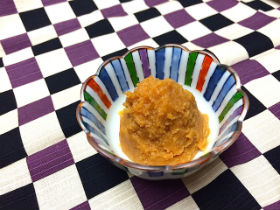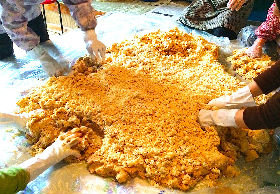Soy beans and Japanese cuisine
Japanese cuisine has many condiments and seasoning. Many of these are made from Soy Beans including Miso paste and Soy Sauce. They are staples of Japanese dishes and there are many many types and flavors depending on the area of Japan and the families.
In this blog by Japanese teacher, Oosawa Miki sensei, talks about one of these standard Japanese condiments.
Read this blog and learn Japanese for free . You can also listen to the audio to learn how to speak Japanese fluently.
味噌と人
Miso and Japanese people

By OOSAWA Miki
日本の料理にはかかせない調味料の一つ、味噌を紹介します。味噌は大豆から作られます。発酵食品なのでとても体にいいんです。

日本では昔から自宅で味噌を作ってきました。私の祖母も毎年作っています。作りかたは簡単です。ゆでた大豆をつぶして、塩と麹を入れて混ぜます。あとは空気を入れないように気をつけながら大きな樽に入れます。そして、最後に味噌の中にごぼうを入れます。こうすると、味噌に魂が入ると言われています。それと味噌の風味もよくなります。
今年は15キロくらいの味噌を作りました。だいたい一年分です。家族だけで作るのは大変なので、近所の人と一緒に作ります。みんなで話したり、疲れたらお茶を飲んだりしながら一日かけて作ります。でも今は店へ行けばすぐ味噌を買うことができるので、自宅で作る人は減ってきました。

味噌作りは大変ですが、手間がかかればかかるほど、とてもおいしくなります。みなさんも日本人の知恵と輪でできた味噌をぜひ食べてみてくださいね。
To listen to this blog, please watch our Youtube video.
味噌(みそ)と人(ひと)
日本(にほん)の料理(りょうり)にはかかせない調味料(ちょうみりょう)の一(ひと)つ、味噌(みそ)を紹介(しょうかい)します。味噌(みそ)は大豆(だいず)から作(つく)られます。発酵食品(はっこうしょくひん)なのでとても体(からだ)にいいんです。
日本(にほん)では昔(むかし)から自宅(じたく)で味噌(みそ)を作(つく)ってきました。私(わたし)の祖母(そぼ)も毎年(まいとし)作(つく)っています。作(つく)りかたは簡単(かんたん)です。ゆでた大豆(だいず)をつぶして、塩(しお)と麹(こうじ)を入(い)れて混(ま)ぜます。あとは空気(くうき)を入(い)れないように気(き)をつけながら大(おお)きな樽(たる)に入(い)れます。そして、最後(さいご)に味噌(みそ)の中(なか)にごぼうを入(い)れます。こうすると、味噌(みそ)に魂(たましい)が入(はい)ると言(い)われています。それと味噌(みそ)の風味(ふうみ)もよくなります。
今年(ことし)は15キロくらいの味噌(みそ)を作(つく)りました。だいたい一年分(いちねんぶん)です。家族(かぞく)だけで作(つく)るのは大変(たいへん)なので、近所(きんじょ)の人(ひと)と一緒(いっしょ)に作(つく)ります。みんなで話(はな)したり、疲(つか)れたらお茶(ちゃ)を飲(の)んだりしながら一日(いちにち)かけて作(つく)ります。でも今(いま)は店(みせ)へ行(い)けばすぐ味噌(みそ)を買(か)うことができるので、自宅(じたく)で作(つく)る人(ひと)は減(へ)ってきました。
味噌(みそ)作(づく)りは大変(たいへん)ですが、手間(てま)がかかればかかるほど、とてもおいしくなります。みなさんも日本人(にほん)の知恵(ちえ)と輪(わ)でできた味噌(みそ)をぜひ食(た)べてみてくださいね。
Miso and Japanese people
Today I'm going to introduce one seasoning that one cannot do without in Japanese cuisine, and that is Miso. Miso made from soy beans. And it is fermented food so it is good for the body.
In Japan people have been making Miso paste in their homes since olden times. My grandmother also makes it herself every year. It is easy to make. You grind down some boiled soy beans and mix it with some salt and rice malt. And then, taking care not to let air get inside it, you place it inside a large barrel. Finally, you put a piece of burdock root into it. This is known as adding a spirit to the Miso. And this also gives the Miso some flavor.
This year, she made about 15 kilograms of Miso. This is about a year's worth. Making it for each family can be quite hard, so she makes it with her neighbors. Everybody talks to each other, when they get tired they stop for a cup of tea and in this way they spend the whole day doing it. But nowadays, if you go to the shops, you can buy Miso anywhere, so the number of people who make Miso at home is decreasing.
Making Miso is a tough job, but the more effort you put into it, the more delicious the Miso paste becomes. Please try some Miso that is made by circle of people and by the old wisdom of Japan.
大豆 (だいず) soy bean
発酵食品 (はっこうしょくひん) fermented food
自宅 (じたく) one’s home
麹 (こうじ) rice malt
樽 (たる) barrel
ごぼう burdock root
魂 (たましい) spirit
風味 (ふうみ) flavor
一年分 (いちねんぶん) one year’s worth of
お互(たが)いに each other
一日(いちにち)かけて doing all day
手間 (てま) time and effort
知恵 (ちえ) wisdom
輪 (わ) circle of people
While all of you may have a different goal, there is one common purpose that you all share, which is to use the Japanese language in order to achieve something. I would be really glad if by learning Japanese here at JOI with me, and with your peers we can help to influence your life – even a little.
When I was a child, I used to perform a musical instrument, and played various kinds of music including pop and jazz. I also love to look at old buildings like temples and shrines and so I often travel. In my class, I would like to introduce some of Japanese culture and the traditions, through learning Japanese, and also introduce some of the characteristics of Japanese people. Lets face our goals together and go for it !

